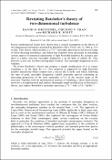Revisiting Batchelor's theory of two-dimensional turbulence
Abstract
Recent mathematical results have shown that a central assumption in the theory of two-dimensional turbulence proposed by Batchelor (Phys. Fluids, vol. 12, 1969, p. 233) is false. That theory, which predicts a X-2/3 k(-1) enstrophy spectrum in the inertial range of freely-decaying turbulence, and which has evidently been successful in describing certain aspects of numerical simulations at high Reynolds numbers Re, assumes that there is a finite, non-zero enstrophy dissipation X in the limit of infinite Re. This, however, is not true for flows having finite vorticity. The enstrophy dissipation in fact vanishes. We revisit Batchelor's theory and propose a simple modification of it to ensure vanishing X in the limit Re -> infinity. Our proposal is supported by high Reynolds number simulations which confirm that X decays like 1/ln Re, and which, following the time of peak enstrophy dissipation, exhibit enstrophy spectra containing an increasing proportion of the total enstrophy (omega(2))/2 in the inertial range as Re increases. Together with the mathematical analysis of vanishing X, these observations motivate a straightforward and, indeed, alarmingly simple modification of Batchelor's theory: just replace Batchelor's enstrophy spectrum X(2/3)k(-1) with (omega(2))k(-1)(In Re)(-1).
Citation
Dritschel , D G , Tran , C V & Scott , R K 2007 , ' Revisiting Batchelor's theory of two-dimensional turbulence ' , Journal of Fluid Mechanics , vol. 591 , pp. 379-391 . https://doi.org/10.1017/S0022112007008427
Publication
Journal of Fluid Mechanics
Status
Peer reviewed
ISSN
0022-1120Type
Journal article
Collections
Items in the St Andrews Research Repository are protected by copyright, with all rights reserved, unless otherwise indicated.

